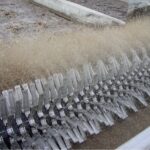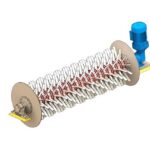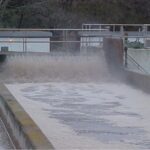The DET10 AERATION ROTOR / SURFACE AERATOR is an aeration unit, with a horizontal shaft, which turns parallel to the water surface. This unit is designed for the biological stages in waste water plants. Its purpose is to oxygenate the water and prevent possible sedimentation. This latter is achieved through the energy transferred.
The aeration rotor is comprised of a circular cross-section shaft to which blades are attached and a drive motor at one end.
The turning motion makes the blades attached to the shaft of the aeration rotor strike the water, creating chop, and thus add oxygen to the body of liquid. These waves also cause water to move around the enclosure.
The number of rotors and their lengths run in accordance with oxygen requirements and tank dimensions. This type of rotor works optimally in enclosures where the water depth is no greater than 4 metres. It is very complicated to achieve good oxygenation and water circulation at greater depths.
This type of aeration system implies a great energy saving. The oxygenation capacity and power used are directly linked to how much of the blade is submerged in the body of liquid. The underwater part of the aeration rotor can be controlled via an adjustable spillway which works automatically. This, in turn, is controlled by a dissolved oxygen probe which adjusts the water level to the oxygen demand required.
The optimal civil work to install the aeration rotor is a walkway comprising two concrete beams, which are at a minimum of 10 cm above the water surface. The gap between the two beams is covered by mobile components and handrails which allow maintenance tasks to be performed comfortably and safely.
MAIN COMPONENTS OF THE DET10 AERATION ROTOR
AERATION CYLINDRER OR ROTOR
It consists of an shaft with a circular cross-section, two safety shields, polyamide blades and a holder at the end opposite the drive unit. The tubular shaft is built using DIN 1629 pipe while the thickness varies according to the length of the pipe. Shields are added to this shaft and the two ends to protect the drive unit from splashes. The polyamide aeration rotor blades are mounted in sets of 12 units and attached to the shaft using stainless steel strips.
DRIVE UNIT
Comprises an epicycloidal gear reducer mounted on a vertical three-phase motor equipped with heating resistors. The drive unit and holder must be anchored to concrete foundations. The drive unit may be equipped with two-speed motors in plants with significant variations in volume.
FLEXIBLE COUPLING
This mechanism links and transmits the torque from the drive unit to the rotor. Built from a special rubber composite with a steel core, its elasticity allows it to absorb the small deviations from alignment in assembly and to absorb the effects of a possible buckling of the shaft.
END MOUNT
The base of this mount is covered in a polyamide lining. It is essentially comprised of two roller bearings, dividers and sealants mounted inside a watertight box with a labyrinth seal. A lubrication system allows the mount to be regularly lubricated.
DEFLECTOR SCREEN (BAFFLE)
This is an optional component typically consisting of a stainless steel plate that bisects the entirety of the site. It is placed at an angle of 30º, submerged below the rotor and in the direction of water movement. This screen directs the air bubbles towards the base of the tank, increasing the oxygenation area and, therefore, increasing the provision of oxygen.






